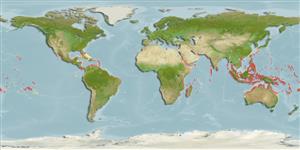Kappaphycus alvarezii (Doty) Doty ex P.C. Silva
Elkhorn sea moss| Native range | All suitable habitat | Point map | Year 2050 |

|
| This map was computer-generated and has not yet been reviewed. |
| Kappaphycus alvarezii AquaMaps Data sources: GBIF OBIS |
Upload your photos
Google image |
No photo available for this species.No drawings available for Areschougiaceae.
Google image |
No photo available for this species.
Classification / Names Common names | Synonyms | CoL | ITIS | WoRMS
Florideophyceae | Gigartinales | Areschougiaceae
Environment: milieu / climate zone / depth range / distribution range Ecology
Sessile. Tropical
Distribution Countries | FAO areas | Ecosystems | Occurrences | Introductions
Atlantic Ocean: in the Caribbean (Cuba); Indian Ocean: in Southern Kenya, east to Indonesia; Pacific Ocean: from China to the South China Sea, south to Indonesia, east to Hawaiian Islands including Federated States of Micronesia and Fiji, and south to Tahiti (Ref. 80701); transported to Hawaii, where it was successfully grown, and thence to island groups of the western Pacific, such as, Guam, Micronesia, Christmas Island, Fanning, Tarawa and other atolls of Kiribati, Fiji, Tonga, and French Oceania. It has been transported to Southern China, Indonesia and also to Southern Africa (Ref. 80758).
Length at first maturity / Size / Weight / Age
Maturity: Lm ? range ? - ? cm
Short description Morphology
Thalli erect, loosely branched, robust, cartilaginous and range from dark greenish brown to deep purple in colour. Main axes cylindrical throughout, 1.5 to 6 mm in diameter when dried.
Lateral ultimate branches arranged secundly to alternately on the axes; they are terete, attenuated to acute or spinose tips varying in length from 1 to 17 mm and 1 to 2 mm in diameter near their bases. Cross-section of a branch shows a medulla composed of small thick-walled cells interspersed among large parenchymatous cells at the centre. Cortical cells very small. Thalli up to 30 cm in height (Ref. 80758).
Principal raw material in producing kappa-carrageenan and widely used in seaweed farming; used by human as food, blanched in boiling water combined with sliced tomatoes and onions, mixed with a sweet sour dressing made of vinegar, salt and sugar; also used in making jelly-type desserts; a source of minerals (Ca, K, Mg, Na, (Pb, Cd); of high commercial interest internationally as source of carrageenan (Ref. 82232); commercially farmed and forms bulk of the dried "Eucheuma" exported abroad (Ref. 80758). Commercially farmed; first discovered on the reef flats of easternmost Sabah and the southwesternmost part of Sulu Archipelago (Ref. 80758).
Life cycle and mating behavior Maturity | Reproduction | Spawning | Eggs | Fecundity | Larvae
Main reference
References | Coordinator | Collaborators
Guiry, M.D. and G.M. Guiry. 2009. (Ref. 80701)
IUCN Red List Status (Ref. 130435)
CITES status (Ref. 108899)
Not Evaluated
CMS (Ref. 116361)
Not Evaluated
Threat to humans
Harmless (Ref. 80758)
Human uses
Fisheries: commercial; aquaculture: commercial
FAO - Aquaculture: production; | FishSource | Sea Around Us
Tools
More information
Internet sources
BHL | BOLD Systems | CISTI | DiscoverLife | FAO(; publication : search) | Fishipedia | GenBank (genome, nucleotide) | GloBI | Gomexsi | Google Books | Google Scholar | Google | PubMed | AlgaeBase | Tree of Life | Wikipedia (Go, Search) | Zoological Record
Estimates based on models
Preferred temperature
(Ref. 115969): 24.7 - 29.3, mean 28.4 (based on 3041 cells).


